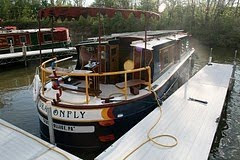 |
| Hard evidence: I knew you wouldn't believe me when I said how fast we are going. The GPS does not lie! |
Our usual rate of travel, four miles per hour, is walking speed . . . the rate at which most travel proceeded for most of human history. Once you get used to this slow pace, 10 mph FEELS fast. Exciting. Even thrilling. We gawked at the riverbanks like hicks taking our first horseless carriage ride, amazed by how quickly we were going.
Approaching the Mel Price Lock and Dam, we saw a barge, tied to the bank, that seemed to be on fire. On closer inspection, we realized a worker was hosing down the outer cover, while at the same time the barge was being loaded with grain. A mist of water and chaff was blowing in the wind.
Twenty percent of all America's grain production gets moved by barges like this. That's ONE-FIFTH! And 90 percent of the grain ON these barges is headed to New Orleans, and then overseas. If you think that's an insignificant part of the U.S. economy, check this Reuters story on barge freight trading.
Next stop after the lock was St. Louis. The wisdom among boaters traveling the Great Loop is, "There's nowhere to dock in St. Louis." But we'd phoned a towboat company that operated a dock not far from the arch, and the owner was welcoming "Sure, we can give you a slip for the night," he said. "Come on down."
 |
| Look but don't touch: Currents were too strong for us to dock in the shadow of the Gateway Arch |
 |
| We need one of these: The big tows have "log catchers" up front, like a locomotive "cow-catcher" |
Our motto: "When the going gets tough, the tough get outta there." (Also, "We have a plan, and we're NOT sticking to it.") We swerved back to the center of the river. We would just have to continue downriver more than 20 miles downriver, to the next safe dockage.
In addition to the current, we were watching out for logs--big, big logs--floating downstream. We couldn't always predict what path they would take. Threading our path was like playing a slo-mo video game.
Meanwhile, the passing tows--the biggest we'd seen, six barges wide by seven barges long--put up standing waves in their wake, waves the size of ocean breakers, a good six feet tall.
And we had a new bit of river topography to be concerned about: The wing dam.
Wing dams are long, narrow piles of rock, underwater. The dams are set at an angle to the shore. We've heard they direct water flow to the middle of the river, keeping the main channel deep enough for the big barges.
 |
| Just past the Mel Price Lock, you bypass a raging stretch of river by going through the "Chain of Rocks" Canal. A canal! We felt right at home. |
To avoid the turbulence created by wingdams (and also the risk of grounding on one) you have to stay within the channel (marked by red and green buoys).
But you ALSO have to stay out of the way of the big barges, which means hugging the very edge of the channel. Once again we found ourselves chanting the mantra that helped us to snake safely through the granite boulder fields of Georgian Bay and the narrow, shallow channels of the Trent Severn: "Stay where you're supposed to be, and you'll be fine!"
 |
| This image has nothing to do with my narrative, I just thought it was cool to see trees full of cattle egrets. |







And speaking of Dam humor... what did the fish say when it hit the concrete barrier? DAM.
ReplyDeleteOk, the "walla walla wing dam" line was funnier...
Oh, thank you so much for the new ear worm! Love the post too!
ReplyDeleteWell it's a change from my most recent, humming "carp they are jumpin' over and over and over . . .
ReplyDelete